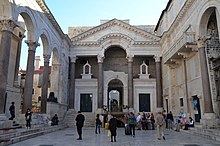ปลายสมัยโบราณ
| ยุคโบราณตอนปลาย Late Antiquity | |
 พระราชวังไดโอคลีเชียนซึ่งเป็นสถาปัตยกรรมของ “ยุคโบราณตอนปลาย” |
ยุคโบราณตอนปลาย (อังกฤษ: Late Antiquity) เป็นสมัยประวัติศาสตร์ที่ใช้โดยนักประวัติศาสตร์ในการบรรยายช่วงเวลาที่เปลี่ยนจากยุคโบราณคลาสสิกไปเป็นยุคกลางทั้งบนแผ่นดินใหญ่ยุโรปและบริเวณเมดิเตอร์เรเนียน ของเขตของสมัยยังคงเป็นเรื่องที่โต้แย้งกันอยู่ แต่นักประวัติศาสตร์คนสำคัญปีเตอร์ บราวน์เสนอว่าเป็นช่วงเวลาระหว่างคริสต์ศตวรรษที่ 2 ถึง ที่ 8 โดยทั่วไปแล้วก็อาจจะเทียบได้กับช่วงเวลาตั้งแต่การสิ้นสุดของวิกฤติการณ์ของคริสต์ศตวรรษที่ 3 (ค.ศ. 235-ค.ศ. 284) ของจักรวรรดิโรมัน ไปจนถึงการจัดระบบบริหารของจักรวรรดิโรมันตะวันออกภายใต้การนำของจักรพรรดิเฮราคลิอัส และการพิชิตดินแดนโดยมุสลิมในยุโรปในคริสต์ศตวรรษที่ 7
จักรวรรดิโรมันประสบกับความเปลี่ยนแปลงอย่างขนานใหญ่ทั้งทางด้านสังคม, วัฒนธรรม และ ระบบการปกครองที่เริ่มขึ้นในรัชสมัยของจักรพรรดิไดโอคลีเชียนผู้ทรงเป็นผู้เริ่มการแบ่งจักรวรรดิออกเป็นสองส่วนคือจักรวรรดิโรมันตะวันออกและจักรวรรดิโรมันตะวันตกที่ปกครองโดยพระจักรพรรดิหลายพระองค์ เริ่มด้วยจักรพรรดิคอนสแตนตินที่ 1 เมื่อจักรวรรดิถูกเปลี่ยนเป็นจักรวรรดิคริสเตียน และการก่อตั้งคอนสแตนติโนเปิลเป็นเมืองหลวง การโยกย้ายถิ่นฐานของกลุ่มชนเจอร์มานิคต่อมาก็บั่นทอนเสถียรภาพของจักรวรรดิยิ่งขึ้นไปอีก ที่ในที่สุดก็นำไปสู่การล่มสลายของจักรวรรดิโรมันตะวันตกในปี ค.ศ. 476 และมาแทนที่ด้วยระบอบพระมหากษัตริย์ของชนเจอร์มานิค หรือ “ระบอบพระมหากษัตริย์ของอนารยชน” ผลก็คือการผสานระหว่างวัฒนธรรมกรีก-โรมัน เจอร์มานิค และ คริสเตียนที่กลายมาเป็นพื้นฐานของวัฒนธรรมของยุโรปตะวันตก
การสูญเสียประชากร, ความรู้ทางเทคโนโลยี และ มาตรฐานความเป็นอยู่ของยุโรปตะวันตกในยุคนี้เป็นลักษณะของสถานภาพที่เรียกว่า “การล่มสลายของสังคม” (Societal collapse) โดยนักเขียนตั้งแต่ยุคฟื้นฟูศิลปวิทยามาจนกระทั่งเมื่อไม่นานมานี้ จากความเสื่อมโทรมที่เกิดขึ้นและการขาดหลักฐานทางประวัติศาสตร์ของยุโรปตะวันตกในช่วงนี้โดยเฉพาะ ในช่วงระหว่างการล่มสลายของจักรวรรดิโรมันตะวันตกมาจนถึงยุคกลาง ทำให้ได้ชื่อว่าเป็น “ยุคมืด” ที่มาแทนที่ด้วยคำว่า “ยุคโบราณตอนปลาย”
บรรณานุกรม
[แก้]- Peter Brown, The World of Late Antiquity: from Marcus Aurelius to Muhammad (AD 150-750), (London: Thames and Hudson) 1989, ISBN 0-393-95803-5
- Peter Brown, 1987. "The World of Late Antiquity Ad 150-750" in A History of Private Life: 1. from Pagan Antiquity to Byzantium, Paul Veyne, editor, ISBN 0-393-95803-5
- Peter Brown, Authority and the Sacred : Aspects of the Christianisation of the Roman World, Routledge, 1997, ISBN 0-521-59557-6
- Peter Brown, The Rise of Western Christendom: Triumph and Diversity 200-1000 AD, Blackwell, 2003, ISBN 0-631-22138-7
- Averil Cameron, The Later Roman Empire: Ad 284-430, Harvard University Press, 1993, ISBN 0-674-51194-8
- Averil Cameron, The Mediterranean World in Late Antiquity Ad 395-600 (Routledge History of the Ancient World), 1993, ISBN 0-415-01421-2
- Averil Cameron et al. (editors), The Cambridge Ancient History, vols. 12-14, Cambridge 1997ff.
- John Curran, Pagan City and Christian Capital: Rome in the Fourth Century, Clarendon Press: Oxford, 2000.
- Peter Dinzelbacher / Werner Heinz: Europa in der Spätantike. Primus, Darmstadt 2007.
- Tomas Hägg (ed.) "SO Debate: The World of Late Antiquity revisited," in Symbolae Osloenses (72), 1997.
- A.H.M. Jones, The Later Roman Empire, 284-602; a social, economic and administrative survey, vols. I, II, University of Oklahoma Press, 1964.
- Fred Kleiner, Christin Mamiya, & Richard Tansey, Gardner's Art Through the Ages, 11th edition, Harcourt Publishers, New York, 2001, pp. 292-323.
- Bertrand Lancon, Rome in Late Antiquity : AD 313 - 604, Routledge, 2001.
- Lee, A.D., Pagans and Christians in Late Antiquity: a Sourcebook, Routledge: New York, 2000.
- Noel Lenski (ed.), The Cambridge Companion to the Age of Constantine, Cambridge University Press, 2006.
- Sam N.C. Lieu and Dominic Montserrat (eds.), From Constantine to Julian: Pagan and Byzantine Views, A Source History, Routledge: New York, 1996.
- Maas, Michael, The Cambridge Companion to the Age of Justinian, Cambridge University Press, 2005.
- Ramsay MacMullen, Christianizing the Roman Empire A.D. 100–400. New Haven, CT; London: Yale University Press, 1984.
- Stephen Mitchell, A history of the Later Roman Empire. AD 284-641, Blackwell, London 2006.
- Barbara Rosenwein, A Short History of the Middle Ages, 2nd edition, Broadview Press, New York, 2004, p. 30-39.
- Rostovtzeff, Michael Ivanovitch, (rev. P. Fraser), The Social and Economic History of the Roman Empire, Clarendon Press: Oxford, 1979.
- Helal Ouriachen, El Housin, 2009, La ciudad bética durante la Antigüedad Tardía. Persistencias y mutaciones locales en relación con la realidad urbana del Mediterraneo y del Atlántico, Tesis doctoral, Universidad de Granada, Granada.
ดูเพิ่ม
[แก้]- ยุคโบราณ
- จักรวรรดิไบแซนไทน์
- การล่มสลายของจักรวรรดิโรมันตะวันตก
- ยุคกลางตอนต้น
- สมัยการโยกย้ายถิ่นฐานในยุโรป
- สงครามโรมัน-เปอร์เซีย
แหล่งข้อมูลอื่น
[แก้]![]() วิกิมีเดียคอมมอนส์มีสื่อเกี่ยวกับ ยุคโบราณตอนปลาย
วิกิมีเดียคอมมอนส์มีสื่อเกี่ยวกับ ยุคโบราณตอนปลาย
- New Advent — The Fathers of the Church, a Catholic website with English translations of the Early Fathers of the Church.
- ORB Encyclopedia's section on Late Antiquity in the Mediterranean from ORB
- Overview of Late Antiquity, from ORB
- Princeton/Stanford Working Papers in Classics, a collaborative forum of Princeton and Stanford to make the latest scholarship on the field available in advance of final publication.
- The End of the Classical World เก็บถาวร 2010-01-10 ที่ เวย์แบ็กแมชชีน, source documents from the Internet Medieval Sourcebook
- Worlds of Late Antiquity เก็บถาวร 2005-06-06 ที่ เวย์แบ็กแมชชีน, from the University of Pennsylvania
| สมัยกลางตอนต้น |
|
|---|---|
| สมัยกลางตอนกลาง | |
| สมัยกลางตอนปลาย |
|
| วัฒนธรรม |
|
| ดูเพิ่ม |
|
| |
Text is available under the CC BY-SA 4.0 license; additional terms may apply.
Images, videos and audio are available under their respective licenses.
